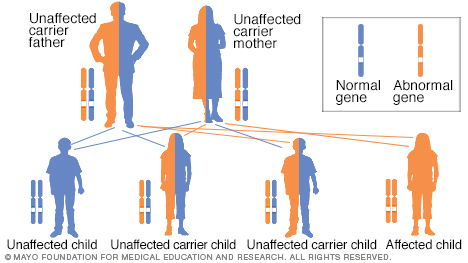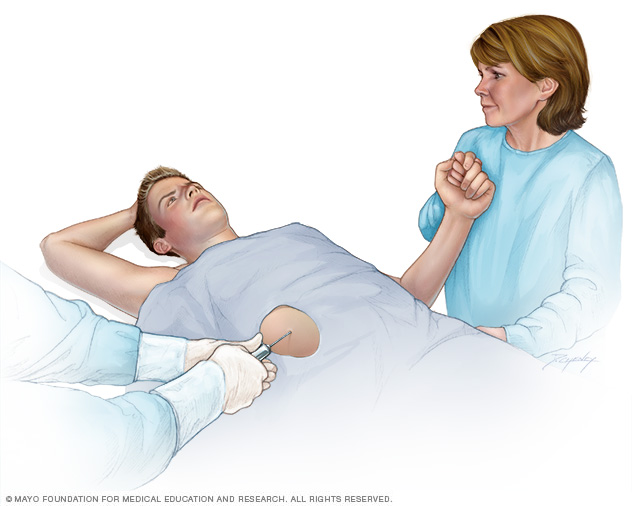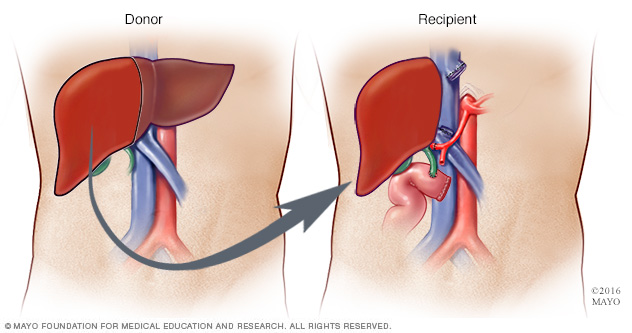Wilson's disease is a rare inherited disorder that causes copper to accumulate in your liver, brain and other vital organs. Most people with Wilson's disease are diagnosed between the ages of 5 and 35, but it can affect younger and older people, as well.
Copper plays a key role in the development of healthy nerves, bones, collagen and the skin pigment melanin. Normally, copper is absorbed from your food, and excess is excreted through a substance produced in your liver (bile).
But in people with Wilson's disease, copper isn't eliminated properly and instead accumulates, possibly to a life-threatening level. When diagnosed early, Wilson's disease is treatable, and many people with the disorder live normal lives.

The liver is your largest internal organ. About the size of a football, it's located mainly in the upper right portion of your abdomen — beneath the diaphragm and above your stomach. A small portion extends into the upper left quadrant.
Symptoms
Wilson's disease is present at birth, but signs and symptoms don't appear until the copper builds up in the brain, liver or other organ. Signs and symptoms vary depending on the parts of your body affected by the disease. They can include:
- Fatigue, lack of appetite or abdominal pain
- A yellowing of the skin and the whites of the eye (jaundice)
- Golden-brown eye discoloration (Kayser-Fleischer rings)
- Fluid buildup in the legs or abdomen
- Problems with speech, swallowing or physical coordination
- Uncontrolled movements or muscle stiffness
When to see a doctor
Make an appointment with your doctor if you have signs and symptoms that worry you, especially if a family member has Wilson's disease.
Causes
Wilson's disease is inherited as an autosomal recessive trait, which means that to develop the disease you must inherit one copy of the defective gene from each parent. If you receive only one abnormal gene, you won't become ill yourself, but you're a carrier and can pass the gene to your children.

To have an autosomal recessive disorder, you inherit two changed genes (mutations), one from each parent. These disorders are usually passed on by two carriers. Their health is rarely affected, but they have one changed gene (recessive gene) and one unaffected gene (dominant gene) for the condition. Two carriers have a 25% chance of having an unaffected child with two unaffected genes (left), a 50% chance of having an unaffected child who also is a carrier (middle), and a 25% chance of having an affected child with two recessive changed genes (right).
Risk factors
You can be at increased risk of Wilson's disease if your parents or siblings have the condition. Ask your doctor whether you should undergo genetic testing to find out if you have Wilson's disease. Diagnosing the condition as early as possible dramatically increases the chances of successful treatment.
Complications
Untreated, Wilson's disease can be fatal. Serious complications include:
- Scarring of the liver (cirrhosis). As liver cells try to make repairs to damage done by excess copper, scar tissue forms in the liver, making it more difficult for the liver to function.
- Liver failure. This can occur suddenly (acute liver failure), or it can develop slowly over years. A liver transplant might be a treatment option.
- Persistent neurological problems. Tremors, involuntary muscle movements, clumsy gait and speech difficulties usually improve with treatment for Wilson's disease. However, some people have persistent neurological difficulty despite treatment.
- Kidney problems. Wilson's disease can damage the kidneys, leading to problems such as kidney stones and an abnormal number of amino acids excreted in the urine.
- Psychological problems. These might include personality changes, depression, irritability, bipolar disorder or psychosis.
- Blood problems. These might include destruction of red blood cells (hemolysis) leading to anemia and jaundice.

A typical liver (left) shows no signs of scarring. In cirrhosis (right), scar tissue replaces typical liver tissue.
Diagnosis
Diagnosing Wilson's disease can be challenging because its signs and symptoms are often hard to tell from those of other liver diseases, such as hepatitis. Also, symptoms can evolve over time. Behavioral changes that come on gradually can be especially hard to link to Wilson's.
Doctors rely on a combination of symptoms and test results to make the diagnosis. Tests and procedures used to diagnose Wilson's disease include:
- Blood and urine tests. Blood tests can monitor your liver function and check the level of a protein that binds copper in the blood (ceruloplasmin) and the level of copper in your blood. Your doctor also might want to measure the amount of copper excreted in your urine during a 24-hour period.
- Eye exam. Using a microscope with a high-intensity light source (slit lamp), an ophthalmologist checks your eyes for Kayser-Fleischer rings, which is caused by excess copper in the eyes. Wilson's disease also is associated with a type of cataract, called a sunflower cataract, that can be seen on an eye exam.
- Removing a sample of liver tissue for testing (biopsy). Your doctor inserts a thin needle through your skin, into your liver and draws a small sample of tissue. A laboratory tests the tissue for excess copper.
- Genetic testing. A blood test can identify the genetic mutations that cause Wilson's disease. Knowing the mutations in your family allows doctors to screen siblings and begin treatment before symptoms arise.

A liver biopsy is a procedure to remove a small sample of liver tissue for laboratory testing. A liver biopsy is commonly performed by inserting a thin needle through your skin and into your liver.
Treatment
Your doctor might recommend medications called chelating agents, which bind copper and then prompt your organs to release the copper into your bloodstream. The copper is then filtered by your kidneys and released into your urine.
Treatment then focuses on preventing copper from building up again. For severe liver damage, a liver transplant might be necessary.
Medications
If you take medications for Wilson's disease, treatment is lifelong. Medications include:
- Penicillamine (Cuprimine, Depen). A chelating agent, penicillamine can cause serious side effects, including skin and kidney problems, bone marrow suppression, and worsening of neurological symptoms. Penicillamine should be used cautiously if you have a penicillin allergy. It also keeps vitamin B-6 (pyridoxine) from working, so you'll need to take a supplement in small doses.
- Trientine (Syprine). Trientine works much like penicillamine but tends to cause fewer side effects. Still, neurological symptoms can worsen when taking trientine.
Zinc acetate (Galzin). This medication prevents your body from absorbing copper from the food you eat. It is typically used as maintenance therapy to prevent copper from building up again after treatment with penicillamine or trientine.
Zinc acetate might be used as primary therapy if you can't take penicillamine or trientine. Zinc acetate can cause stomach upset.
Your doctor might also recommend other medications for symptom relief.
Surgery
If your liver damage is severe, you might need a liver transplant. During a liver transplant, a surgeon removes your diseased liver and replaces it with a healthy liver from a donor.
Most transplanted livers come from donors who have died. But in some cases a liver can come from a living donor, such as a family member. In that case, the surgeon removes your diseased liver and replaces it with a portion of the donor's liver.

During living liver donation, surgeons remove approximately 40% to 70% of the donor liver and place it into the recipient.
Lifestyle and home remedies
If you have Wilson's disease, your doctor will likely recommend that you limit the amount of copper you consume in your diet. You might also want to have your tap water's copper levels tested if you have copper pipes in your home. And be sure to avoid multivitamins that contain copper.
Foods that contain high amounts of copper include:
- Liver
- Shellfish
- Mushrooms
- Nuts
- Chocolate
Preparing for an appointment
You'll likely first see your family doctor or a general practitioner. You then might be referred to a doctor who specializes in the liver (hepatologist).
What you can do
When you make the appointment, ask if there's anything you need to do in advance, such as restrict your diet for blood tests.
Make a list of:
- Your symptoms and when they began
- Key personal information, including major stresses, other medical conditions you have and any family history of Wilson's disease
- All medications, vitamins or other supplements you take, including doses
- Questions to ask your doctor
Take a family member or friend along, if possible, to help you remember the information you're given.
For Wilson's disease, questions to ask your doctor include:
- What tests do I need?
- What treatment do you recommend?
- What are the side effects of the recommended treatment?
- Are there other treatment options?
- I have these other health conditions. How can I best manage them together?
- Are there restrictions I need to follow?
- Should I see a specialist?
- Should my family be tested for Wilson's disease?
- Are there brochures or other printed material that I can have? What websites do you recommend?
Don't hesitate to ask other questions.
What to expect from your doctor
Your doctor is likely to ask you several questions, such as:
- Have your symptoms been continuous or occasional?
- How severe are your symptoms?
- What, if anything, seems to improve your symptoms?
- What, if anything, appears to worsen your symptoms?
Copyright © 1998-2025 Mayo Foundation for Medical Education and Research (MFMER). All rights reserved.